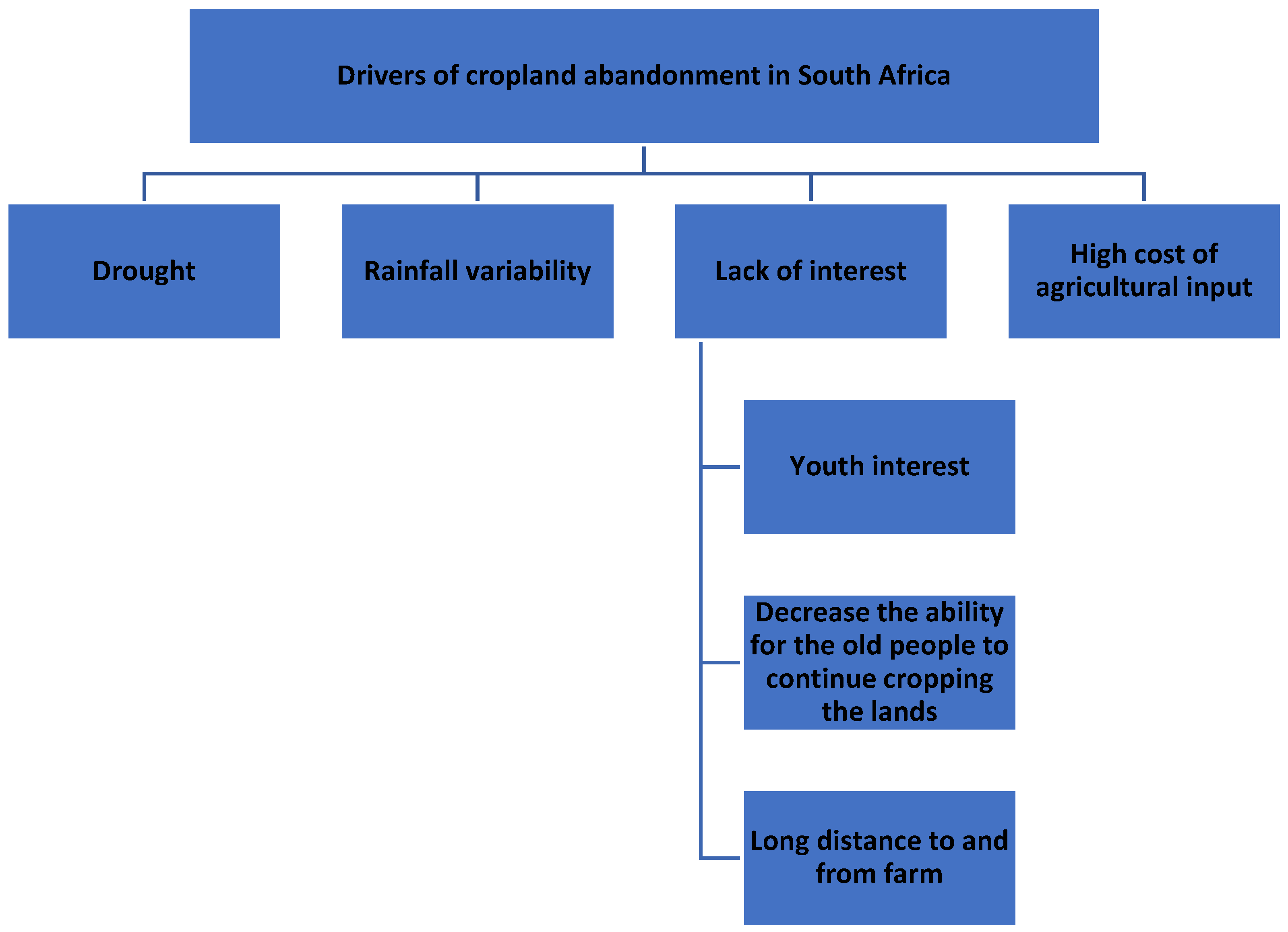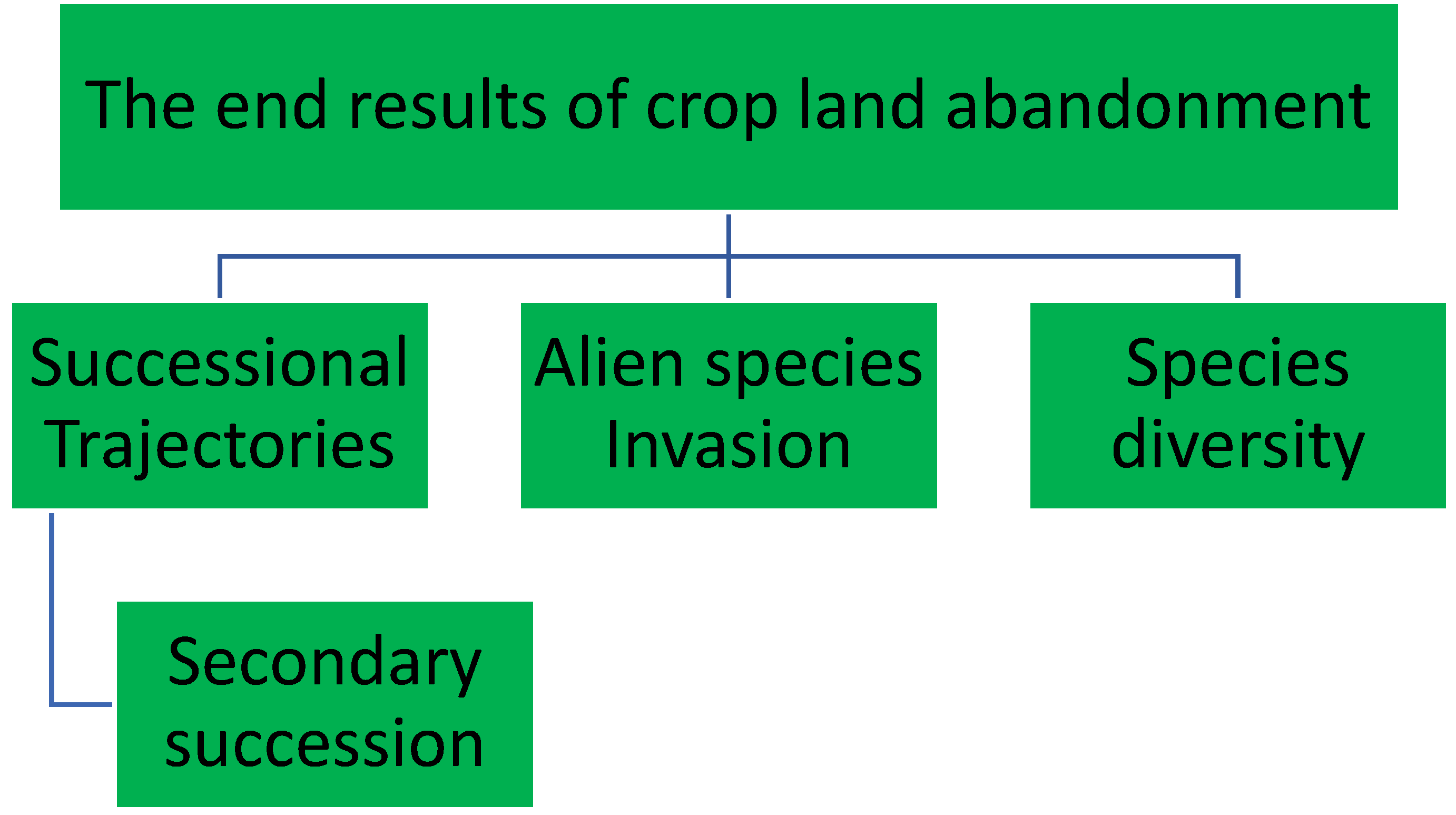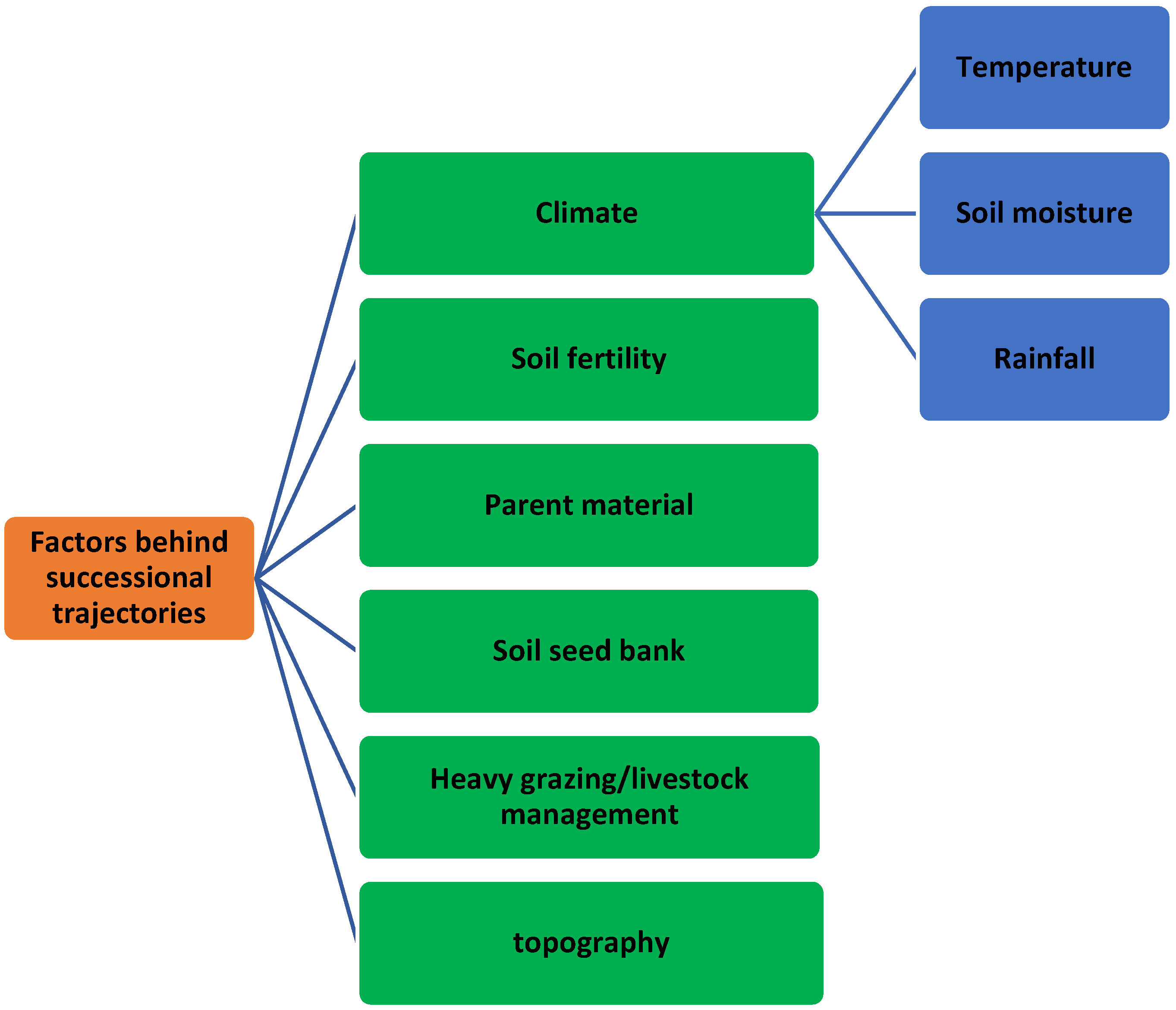
| Version | Summary | Created by | Modification | Content Size | Created at | Operation |
|---|---|---|---|---|---|---|
| 1 | Khuliso Ravhuhali | -- | 2414 | 2022-05-24 10:27:08 | | | |
| 2 | Beatrix Zheng | Meta information modification | 2414 | 2022-05-25 02:55:38 | | |
Video Upload Options
There is no standardised definition of agricultural land abandonment; however, a simple definition is the cessation of agricultural activities on a given surface of land. The term agricultural land abandonment is inclusive of land previously used for crops, vegetables, fruit trees, and cultivated and natural pastures. Other agricultural land abandonment studies specifically focus on crops, hence terms such as cropland abandonment, formerly arable lands, and old arable lands or fields are used. Others specify that for the land to qualify as abandoned, it should not be used for any other activity such as urbanisation or afforestation. Therefore, in the context of the rural areas of Africa wherein the cessation of cropping the land is used for grazing, the definition of cropland abandonment suffices. Baxter and Calvert define cropland abandonment as a process of withdrawing cropland from active agricultural production without a plan for crop cultivation in the immediate future. The cessation is usually due to a decline in economic viability even after changes in farming practices. Cessation results in natural succession wherein grasses, shrubs, and trees colonise former cropping lands; it can also result in land degradation. In the former homeland communal areas of South Africa, where the main agricultural activity involves cropping and livestock production, by default if the land is not used for cropping it turns into a grazing area. The same trend of abandoned cropping lands being used for grazing was also reported in Botswana. Therefore, the definition of abandoned cropping land is land mainly used for grazing. The areas are sometimes also called old fields, fallow, or idle fields. Some have turned to be secondary grasslands.
1. Causes of Cropland Abandonment

2. Economic Impacts Associated with Abandonment of Croplands
3. Successional Trajectories


3.1. Alien Species Invasion
3.2. Species Richness
4. Conclusions
References
- Khanal, N.R.; Watanabe, T. Abandonment of Agricultural Land and Its Consequences. Mt. Res. Dev. 2006, 26, 32–40.
- Bista, R.; Zhang, Q.; Parajuli, R.; Karki, R.; Chhetri, B.B.K.; Song, C. Cropland Abandonment in the Community-Forestry Landscape in the Middle Hills of Nepal. Earth Interact. 2021, 25, 136–150.
- Hobbs, R.J.; Cramer, V.A. Why old fields? Socioeconomic and ecological causes and consequences of land abandonment. In Old Fields: Dynamics and Restoration of Abandoned Farmland; Cramer, V.A., Hobbs, R.J., Eds.; Island Press: Washington, DC, USA, 2007; pp. 1–14.
- Keenleyside, C.; Tucker, G. Farmland Abandonment in the EU: An Assessment of Trends and Prospects; Institute for European Environmental Policy: London, UK, 2010.
- Baxter, R.E.; Calvert, K.E. Estimating available abandoned cropland in the United States: Possibilities for energy crop production. Ann. Assoc. Am. Geogr. 2017, 107, 1162–1178.
- Zantsi, S.; Bester, B. Farming households’livelihoods strategies in Ndabakazi villages, Eastern Cape: What are the implications to extension services? S. Afr. J. Agric. Ext. 2019, 47, 120–134.
- Benayas, J.M.R.; Martins, A.; Nicolau, J.M.; Schulz, J.J. Abandonment of agricultural land: An overview of drivers and consequences. CAB Rev. 2007, 2, 57.
- Mzuyanda, C.; Phiwe, J.; Mdoda, L. Factors Influencing Rain-Fed Agricultural Land Abandonment in Mnquma and Mbashe Municipalities, Eastern Cape. Int. J. Recent Technol. Eng. 2020, 9, 1213–1219.
- Hull, E. The social dynamics of labour shortage in South African small-scale agriculture. World Dev. 2014, 59, 451–460.
- Blair, D.; Shackleton, C.M.; Mograbi, P.J. Cropland abandonment in South African smallholder communal lands: Land cover change (1950–2010) and farmer perceptions of contributing factors. Land 2018, 7, 121.
- Hebinick, P. Post-apartheid land and agrarian reform policy and practices in South Africa: Themes, processes and issues. In The Shadow of Policy—Everyday Practices in South Africa’s Land and Agrarian Reform; Hebinck, P., Cousins, B., Eds.; Witwatersrand University Press: Johannesburg, South Africa, 2013; pp. 3–28.
- Plieninger, T.; Gaertner, M.; Hui, C.; Huntsinger, L. Does land abandonment decrease species richness and abundance of plants and animals in Mediterranean pastures, arable lands and permanent croplands? Environ. Evid. 2013, 2, 3.
- Roberts, V.G.; Adey, S.; Manson, A.D. An investigation into soil fertility in two resource-poor farming communities in KwaZulu-Natal (South Africa). S. Afr. J. Plant Soil. 2003, 20, 146–151.
- Mandiringana, O.T.; Mnkeni, P.N.S.; Mkile, Z.; van Averbeke, W.; Van Ranst, E.; Verplancke, H. Mineralogy and fertility status of selected soils of the Eastern Cape Province, South Africa. Commun. Soil Sci. Plant Anal. 2005, 36, 2431–2446.
- Kakembo, V.; Rowntree, K. The relationship between land use and soil erosion in the communal lands near Peddie Town, Eastern Cape, South Africa. Land Degrad. Dev. 2003, 14, 39–49.
- Quintas-Soriano, C.; Buerkert, A.; Plieninger, T. Effects of land abandonment on nature contributions to people and good quality of life components in the Mediterranean region: A review. Land Use Policy 2022, 116, 106053.
- Munroe, D.K.; van Berkel, D.B.; Verburg, P.H.; Olson, J.L. Alternative trajectories of land abandonment: Causes, consequences and research challenges. Curr. Opin. Environ. Sustain. 2013, 5, 471–476.
- Shackleton, C.M.; Shackleton, S.E.; Cousins, B. The role of land-based strategies in rural livelihoods: The contribution of arable production, animal husbandry and natural resource harvesting in communal areas in South Africa. Dev. S. Afr. 2001, 18, 581–604.
- Corbelle-Rico, E.; Sánchez-Fernández, P.; López-Iglesias, E.; Lago-Peñas, S.; Da-Rocha, J.M. Putting land to work: An evaluation of the economic effects of recultivating abandoned farmland. Land Use Policy 2022, 112, 105808.
- Prishchepov, A.V.; Radeloff, V.C.; Baumann, M.; Kuemmerle, T.; Müller, D. Effects of institutional changes on land use: Agricultural land abandonment during the transition from state-command to market-driven economies in post-Soviet Eastern Europe. Environ. Res. Lett. 2012, 7, 024021.
- Van Rheede van Oudtshoorn, F.P. The Evaluation of Various Reseeding Methods for Restoring Old Croplands in the Highveld Region of South Africa. Master’s Thesis, University of South Africa, Pretoria, South Africa, 2007.
- Albert, Á.J.; Mudrák, O.; Jongepierová, I.; Fajmon, K.; Frei, I.; Ševčíková, M.; Klimešová, J.; Doležal, J. Grassland restoration on ex-arable land by transfer of brush-harvested propagules and green hay. Agric. Ecosyst. Environ. 2019, 272, 74–82.
- Gulwa, U.; Mgujulwa, N.; Beyene, S.T. Effect of grass-legume intercropping on dry matter yield and nutritive value of pastures in the Eastern Cape Province, South Africa. Univers. J. Agric. Res. 2017, 5, 355–362.
- Davis, J.K.; Ainslie, A.; Finca, A. Coming to grips with ‘abandoned arable’ land in efforts to enhance communal grazing systems in the Eastern Cape province, South Africa. Afr. J. Range Forage Sci. 2008, 25, 55–61.
- Ruprecht, E. Successfully recovered grassland: A promising example from Romanian old-fields. Restor. Ecol. 2006, 14, 473–480.
- Ruwanza, S. Furrows as centers of restoration in old fields of Renosterveld, South Africa. Restor. Ecol. 2017, 35, 289–291.
- Robinson, S.J.B.; van den Berg, E.; Meirelles, G.S.; Ostle, N. Factors influencing early secondary succession and ecosystem carbon stocks in Brazilian Atlantic Forest. Biodivers. Conserv. 2015, 24, 2273–2291.
- Paz, C.P. Patterns of Secondary Forest Recovery in Two Soil Types. Ph.D. Thesis, James Cook University, Townsville, Australia, 2016.
- Cramer, V.A.; Hobbs, R.J.; Standish, R.J. What’s new about old fields? Land abandonment and ecosystem assembly. Trends Ecol. Evol. 2008, 23, 104–112.
- Teira, A.G.; Peco, B. Modelling old field species richness in a mountain area. Plant Ecol. 2003, 166, 249–261.
- Crouzeilles, R.; Ferreira, M.S.; Chazdon, R.L.; Lindenmayer, D.B.; Sansevero, J.B.; Monteiro, L.; Iribarrem, A.; Latawiec, A.E.; Strassburg, B.B. Ecological restoration success is higher for natural regeneration than for active restoration in tropical forests. Sci. Adv. 2017, 3, e1701345.
- Zethof, J.H.T.; Cammeraat, E.L.H.; Nadal-Romero, E. The enhancing effect of afforestation over secondary succession on soil quality under semiarid climate conditions. Sci. Total Environ. 2019, 652, 1090–1101.
- Gotosa, T.N.; Gotosa, J.; Katsvanga, C.A.T.; Nyakudya, I.W.; Mapaure, I. Woody vegetation diversity and regeneration in an abandoned sugar estate in semi-arid Zimbabwe. J. Anim. Plant Sci. 2013, 23, 1370–1378.
- Lesschen, J.P.; Cammeraat, L.H.; Kooijman, A.M.; van Wesemael, B. Development of spatial heterogeneity in vegetation and soil properties after land abandonment in a semi-arid ecosystem. J. Arid Environ. 2008, 72, 2082–2092.
- Chambers, J.C.; Eldredge, E.P.; Snyder, K.A.; Board, D.I.; de Queiroz, T.F.; Hubbard, V. Restoring abandoned agricultural lands in cold desert shrublands: Tradeoffs between water availability and invasive species. Invasive Plant Sci. Manag. 2014, 7, 176–189.
- Porensky, L.M.; Leger, E.A.; Davison, J.; Miller, W.W.; Goergen, E.M.; Espeland, E.K.; Carroll-Moore, E.M. Arid old-field restoration: Native perennial grasses suppress weeds and erosion, but also suppress native shrubs. Agric. Ecosyst. Environ. 2014, 184, 135–144.
- Chang, X.; Chai, Q.; Wu, G.; Zhu, Y.; Li, Z.; Yang, Y.; Wang, G. Soil organic carbon accumulation in abandoned croplands on the loess plateau. Land Degrad. Dev. 2017, 8, 1519–1527.
- Riedel, S.M.; Epstein, H.E. Edge effects on vegetation and soils in a Virginia old-field. Plant Soil. 2005, 270, 13–22.
- Ingram, J.; Kirkpatrick, J.B. Native vertebrate herbivores facilitate native plant dominance in old fields while preventing native tree invasion: Implications for threatened species. Pac. Conserv. Biol. 2013, 19, 331–342.
- Hajdu, F.; Neves, D.; Granlund, S. Changing Livelihoods in Rural Eastern Cape, South Africa (2002–2016): Diminishing Employment and Expanding Social Protection. J. S. Afr. Stud. 2020, 46, 743–772.
- Kuebbing, S.E.; Souza, L.; Sanders, N.J. Effects of co-occurring non-native invasive plant species on old-field succession. Forest Ecol. Manag. 2014, 324, 196–204.
- Jevon, T.; Shackleton, C.M. Integrating local knowledge and forest surveys to assess Lantana camara impacts on indigenous species recruitment in Mazeppa Bay, South Africa. Hum. Ecol. 2015, 43, 247–254.
- Walton, B.A. Vegetation and Dynamics of Renosterveld at Agter-Groeneberg Conservancy, Western Cape, South Africa. Ph.D. Thesis, University of Stellenbosch, Stellenbosch, South Africa, 2006.
- Meiners, S.J.; Pickett, S.T.A.; Cadenasso, M.L. Exotic plant invasions over 40 Years of old field successions: Community patterns and associations. Ecography 2002, 25, 215–223.
- Gioria, M.; Jarošík, V.; Pyšek, P. Impact of invasions by alien plants on soil seed bank communities: Emerging patterns. Perspect. Plant Ecol. Evol. Syst. 2014, 16, 132–142.
- Ruwanza, S. Invasion of abandoned agricultural fields by Acacia mearnsii affect soil properties in Eastern Cape, South Africa. Appl. Ecol. Environ. Res. 2017, 15, 127–139.
- Scorer, C.; Mantel, S.K.; Palmer, A.R. Do abandoned farmlands promote spread of invasive alien plants? Change detection analysis of black wattle in montane grasslands of the Eastern Cape. S. Afr. Geogr. J. 2018, 101, 36–50.
- Kakembo, V. Vegetation patchiness and implications for landscape function: The case of Pteronia incana invader species in Ngqushwa Rural Municipality, Eastern Cape, South Africa. Catena 2009, 77, 180–186.
- Haussmann, N.S.; Delport, C.; Kakembo, V.; Mashiane, K.K.; le Roux, P.C. Restoration Potential of Invaded Abandoned Agricultural Fields: What Does the Seed Bank Tell Us? Restor. Ecol. 2019, 27, 813–820.
- Shackleton, R.; Shackleton, C.; Shackleton, S.; Gambiza, J. Deagrarianisation and forest revegetation in a biodiversity hotspot on the Wild Coast, South Africa. PLoS ONE 2013, 8, e79939.
- Njwaxu, A.; Shackleton, C.M. The Availability of Non-Timber Forest Products under Forest Succession on Abandoned Fields along the Wild Coast, South Africa. Forests 2019, 10, 1093.
- Giourga, H.; Margaris, N.S.; Vokou, D. Effects of Grazing Pressure on Succession Process and Productivity of Old Fields on Mediterranean Islands. Environ. Manag. 1998, 22, 589–596.
- Zhang, J.T. Succession analysis of plant communities in abandoned croplands in the eastern Loess Plateau of China. J. Arid Environ. 2005, 63, 458–474.
- Forey, E.; Dutoit, T. Vegetation, soils and seed banks of limestone grasslands are still impacted by former cultivation one century after abandonment. Community Ecol. 2012, 13, 194–202.
- Wehn, S.; Taugourdeau, S.; Johansen, L.; Hovstad, K.A. Effects of abandonment on plant diversity in semi-natural grasslands along soil and climate gradients. J. Veg. Sci. 2017, 28, 838–847.
- Gibson, C.W.D.; Watt, T.A.; Brown, V.K. The use of sheep grazing to recreate species-rich grassland from abandoned arable land. Biol. Conserv. 1987, 42, 165–183.
- Sebego, R.J. Field Abandonment and Secondary Succession: Implications on the Quality of Grazing in Kweneng-North, Botswana. Botsw. Notes Rec. 2006, 83, 43–59.




